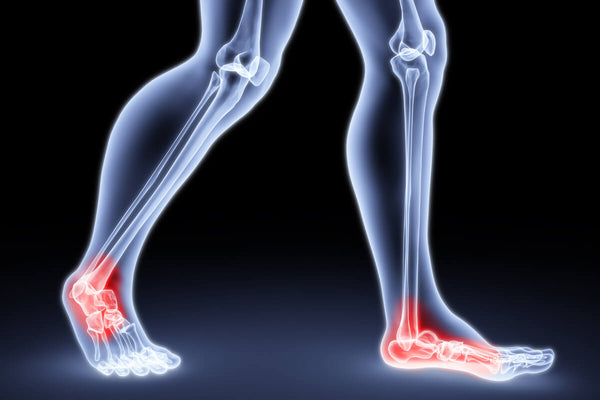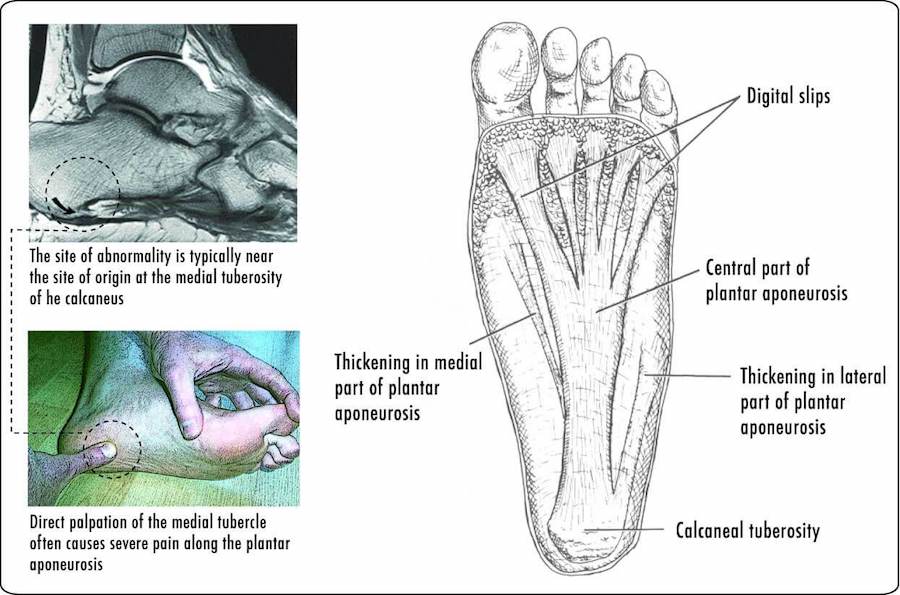
Top 3 Symptoms Of Plantar Fasciitis
For some, it comes on quick. For others the symptoms of plantar fasciitis may come on slow, over an extended period of time. While it's good to know there are solutions to help such as our orthotic arch support insoles, it's best to first know what may be going on with your foot health and if you're potentially suffering from these symptoms of plantar fasciitis.
But one thing is for certain, plantar fasciitis symptoms do come with certain aches and pains that are far telling of the fact that you may be one of the "lucky ones" to have come down with this should-be temporary plantar fascia condition.
To start off our list I want to introduce two physical therapists that can teach you a lot about the symptoms of plantar fasciitis. They have their own top 3 plantar fasciitis symptoms they talk about in this video below.
We've been dealing with foot pain since 1997 here at Natural Foot Orthotics®, and agree with everything stated by physical therapists Bob Schrupp and Brad Heineck in this video on plantar fasciitis symptoms...
Plantar Fasciitis Symptoms Video
Now let's get onto our top 3 most often reported symptoms associated with plantar fasciitis that we here at Natural Foot Orthotics have come across over the years!
1. Heel Pain

The plantar fascia is similar to like a leather strap that’s attached from your heel to the ball of your foot to your toes. When this leather strap-like plantar fascia gets inflamed, you’ll often feel it as heel pain right at the base of your heel, especially with the first few steps in the morning. It will usually get better as time continues on in the morning.
Plantar Fasciitis Heel Pain:
- You feel a sharp pain directly under your heel.
- You feel sharp pains in other areas of the heel, from the bottom to the outsides.
- It's to the point you can't run. You can't stand for long periods of time.
- If the pain has started on both sides, this can be something systemic, but plantar fasciitis can spread if not tended to. This is why a clinical assessment is highly suggested.
- Squeezing your heel bone is painful
This is from a fellow plantar fasciitis sufferer. She explains how her plantar fasciitis symptoms are on the heel not her foot arch:
"My pain is no where near my arch, it hurts the most at the outer back of my heel. I have had an x ray a year before and had a heel spur that was bothering me but I got the cortisone shot and that no longer bothers me."
According to Runner's World,
"The condition of plantar fasciitis can also be caused by biomechanical issues, including flat feet with high arches or excessive pronation. A sudden increase in training mileage or beginning speed training, wearing worn running shoes, running on hard surfaces like asphalt or concrete can also lead to plantar fasciitis. Wearing high heels all day and then switching into flat running shoes may also cause the issue." (source)
Anatomy Of The Foot's Fascia

Image source: Deep Sole Anatomy - Wikipedia
Even with plantar fasciitis reaching a large number of the population today, the only way to truly find out if that's what your symptoms are from, it's best to just schedule yourself in for an medically experienced and professional assessment.
Many Natural Foot Orthotics® customers have had their plantar fasciitis symptoms healed almost right away. You can see each orthotic insoles testimonials on our product pages. They're not padded. They are medical grade and take a few days to a week to break in properly.
Our Stabilizer orthotic insoles are one solution to this pesky issue of plantar fasciitis. They're designed for it. Normally it goes away on its own. Orthotics can be of great assistance in the healing process and for future prevention.
Pain In Heel Of Foot
Is it From Plantar Fasciitis? Many with plantar fasciitis feel the heel pain symptoms most often or first before the others. However, you should know that there are many heel pain causes, and just because you have heel pain, it does not mean it is a symptom of plantar fasciitis.
Heel pain is also connected with other foot related issues:
- Stress fractures
- Tendonitis (one of its various forms)
- Heel spurs
Heel Spurs Symptoms and Plantar Fasciitis
An X-ray can reveal bone spurs, but it’s important to note that many with bone spurs don’t actually feel them. Just in case you assume a bone spur is causing your pain, many with bone spurs wouldn't ever know...
But if you do happen to have a bone spur, the underlying cause of your pain can be something other that that heel spur or bone spur. The plantar fascia can be part of the heel pain problem. Every case is individual. Heel pain is one of the main symptoms of plantar fasciitis.
Morning Plantar Fasciitis Pain
Your first few steps out of bed can often be the worst steps if you're experiencing plantar fasciitis symptoms. Some feel this morning pain in their heel, others in their foot's arch.
Likewise, you can feel this same pain after being inactive for a long time, like if you're sitting and working for hours at a desk, or just lying down for a long time.
If this pain stems from an inflamed plantar fasciitis, after doing an activity, you can also feel pain, once you start to rest again. You'll generally feel the plantar fasciitis symptoms after a prolonged period of inactivity.
2. Arch & Foot Pain
It’s not just the heel that can signal pain associated with plantar fasciitis. Arch pain and many other pains around the foot can be plantar fasciitis symptoms as well.
The #1 symptom of plantar fasciitis is the heel pain, right at the bottom of the heel. However, many will feel pain right in the middle-bottom part of their foot arch. The arch pain plantar fasciitis symptom, if it's not the heel pain, then it can be right in front of the heel at the bottom of your foot arch.
Remember, it can start in one place and spread to more of your foot. It's always best get a proper medical assessment if you're experiencing these plantar fasciitis symptoms. We always recommend a clinical assessment.
It's good, however, to learn from others' experiences dealing with plantar fasciitis symptoms.
Do You Feel Pain If You Do The Sprint Position?

One signal of this type of symptom of plantar fasciitis is pain during this sprinting runner’s position and action.
If you’ve ever watched the olympic runners, you’ll know this position. NFL players will hold this position before the snap in much the same way. This crouching position that gets your body ready to pounce, run, sprint, etc. is a painful one if you happen to be dealing with plantar fasciitis symptoms.
Top Plantar Fasciitis Symptoms:
- Heel pain (#1 plantar fasciitis symptom)
- Arch & foot pain
- Pain that spreads
Now let’s go group the rest of the connected plantar fasciitis symptoms to where they often spread to.. your calves, knees, hips and lower back.
3. Tight Calves, Knee Pain & More

Knee pain, tight calves, lower back pain and hip pain are ALL connected. That's because our fascia is all connected. The injuries to it can spread if not tended to in one way or another.
Fascia is a connective tissue. It connects everything from the muscles to bones, ligaments, and tendons. It’s holds your body together and is made up in large portion of collagen, which name stems from the greek word for “glue” . So fascia spans throughout your whole body, there are four different kinds (structural, inter-sectoral, spinal & visceral), and even all are connected throughout your body.
This group of muscles, tendons, and ligaments all interconnected are a "myofascial kinetic chain".
They help make movement possible.
Knee Pain & Plantar Fasciitis:
So how does plantar fasciitis cause knee pain?
Knee pain can contribute to plantar fasciitis and vice versa; knee pain can be a symptom of plantar fasciitis.
It may be an overuse injury which can be caused by starting a new running routine or high impact activity too much too soon…. you ramped up too fast. This is a major thing that ambitious people who've led sedentary lifestyles a bit too long will encounter.
Right when you make the commitment to do something good for yourself, you can get attacked with a debilitating (yet very treatable) symptoms of plantar fasciitis!
The following is a wonderful excerpt from the self proclaimed Plantar Fasciitis guru over at PFSurvivalGuide. He knows his stuff. This excerpt below will help you learn more about your potential symptoms of plantar fasciitis:
“The hamstrings are connected to the plantar fascia (same kinetic chain) and they are responsible for stabilizing the knee. When the hamstrings get tight and dysfunctional, they cannot contract as well (or know what position they are in), and the knee is free to hurt itself more easily. When these muscles cause dysfunction to the knee, it is unstable. An unstable joint is prone to injury."(source)
He goes on...
"Altered hamstring muscle activity causes dysfunction in the pelvis, back, and ankle. Simply because all of these structures are closely connected. When these joints are not working properly, other muscles must compensate. When the hamstrings are dysfunctional, the quadriceps will need to compensate. This further perpetuates the downward spiral and causes pain and problems to spread. (source)
Your Knees Start To Hurt
Painful feet can cause you to change how you walk, in order to avoid that pain. This can then add a newfound pressure on your knees, possibly from an angle it doesn't like to hinge on each step.
A bad gait can cause knee pain.
And a bad gait plus knee pain, can be a plantar fasciitis symptom.
What Causes Plantar Fasciitis Symptoms In The Knees?
- The same activity that caused your plantar fasciitis can also have given damage to your knee
- If your feet are forcing you to walk abnormally, knees don't like that
- If your feet are forcing you to walk abnormally, you are more likely to hurt things up the fascia chain (your calves, knees, even hips)
- the knee is a hinge joint. If you force it to tweak consistently from overcompensating from another injury, the unnatural movement your knee now makes when walking can eventually lead to problems
Tight Calves:
A huge risk factor and symptom of plantar fasciitis are tight calf muscles. They connect to your knees.
I'm sure many a plantar fasciitis sufferer has neglected stretching their calves before a workout or activity at least a handful of times...
Hip Pain:
Because plantar fasciitis symptoms can spread if not tended to and treated, the hips can become one of the victims of the spread. Your body overcompensates for the new movements cause by pains possibly from plantar fasciitis symptom pains. And when it does this problems can result in your hips too.
Orthotic insoles help greatly to improve your gait right away. There are several non-invasive solutions and it gets treated often on its own. However, sometimes surgery is used in severe cases. The one thing you want to avoid is the spread of symptoms of plantar fasciitis to other parts of your body. and eventually to your hips. The best and only course of action is to let a doctor take a look at the symptoms and pains.
Lower Back Pain:

“Your hips and lower back start to hurt
Feet pain, tight calves, knee pain, and now a bad gait? These are enough to then spread up further and effect your lower back and hips. This is why it's necessary to take plantar fasciitis symptoms seriously. It's very treatable and can go away on its own, but it can also spread upwards if the symptoms and pains persist and worsen.
The Many Symptoms Of Plantar Fasciitis:
Some things you'll start to feel when your plantar fascia or overall fascia is in bad shape is or can be a hunched posture, unsymmetrical body posture: leaning to one side for example with shoulder hunched so to make one shoulder higher than the other, lack of flexibility, mobility & strength in general, cellulite and reoccurring injuries too.
Plantar Fascia is connected to a myofascial kinetic chain and contains the structures below: (source)
- Heel Pain
- Foot Flexors (bottom of foot muscles)
- Calf Muscles
- Hamstring Muscles
- Sacrotuberous ligament
- Back Muscles
- Back of Neck Muscles
Plantar Fasciitis symptoms, as listed out on the Kaiser Permanente website: (source)
- Sharp, stabbing pain on the bottom or side of the heel or in the arch of the foot.
- Pain that is worse in the morning or after any period of inactivity. As you begin to move around, the pain level usually improves.
- Pain that gets worse after a prolonged period of standing, walking, or running.
- Pain can last for several weeks or months and can range from mild to severe.
Plantar Fasciitis Treatments
From hamstring foam rolling stretches, to effective plantar fascia stretches, this N.A.S.M. article shares great plantar fasciitis treatment exercises and information that will help you put your plantar fasciitis symptoms and worries to rest.
A Clinical Assessment Is Important
As a starting point, an X-ray is good to rule out bone spurs or fractures. Everyone's experience can be different, but they all focus down to around the same few areas, the heel, the foot and even the ankles, calves, knees, hips, and lower back. For some it is the inside portion of the heel, where it meets the arch. For others,
From foam rolling out your calves, to massages and more, there are many things you can do for the occasional lower body pains.
But what happens when you notice something not going away? A new pain? Maybe a sudden pain in your feet that isn’t getting better.
The best thing to do is to get medically tested. MRI’s are always worst case, but often checking for plantar fasciitis symptoms are the first step you can do right now, right away, or at least it's something to start paying attention to.
A clinical assessment is always best if you're experiencing what are considered to be plantar fasciitis symptoms. A podiatrist will often do an ultrasound or X-ray as both can do good at ruling things out. Ultrasounds can measure the fascia depth throughout your foot. X-rays show heel spurs, which can end up being symptoms of plantar fasciitis.
Some have severe plantar fasciitis, and zero bone spurs.
Others are full of bone spurs and pain, but with zero plantar fasciitis.
Conclusion: Symptoms Of Plantar Fasciitis
Healing plantar fasciitis is very possible. It helps to catch the signs of plantar fasciitis as soon as you notice them. For a large majority of people, the pain and problem can go away on its own with proper rest and care. It's great news to hear if you have symptoms plantar fasciitis.
You do have to tend to plantar fascia pain as we've learned that symptoms can spread. Clinical treatment always recommended. Imaging or an ultrasound, can greatly help identify, confirm and provide you enough information to create a proper healing plan. Should you include orthotics into this healing plan, please take a look at our Natural Foot Orthotics orthotic insoles.
Our Stabilizer Orthotics:
- Original: Arch supports for high arches
- Intermediate: Arch supports for medium arches
- Slim: Arch supports for flat feet or sunken arches
- Fashion: Arch supports for high heel and dress shoes
- Cloud Comfort: Arch supports for all-day wear
If you have any questions about how foot orthotics could help you, please let us know in the comments or the contact page.


Leave a comment
Also in Blog
Effective Remedies To Ease Plantar Fasciitis Pain
October 17, 2024
Continue reading
Can Your Shoes Cause Plantar Fasciitis?
October 17, 2024
Did you know that your favorite shoes may actually be what is responsible for your plantar fasciitis and related issues? It’s not the best news, but learning this may help you stop hurting your own feet without knowing it. But the good news is that you don’t have to throw your shoes out if that is the case for you.
Continue reading
6 Causes Of Heel Pain
October 17, 2024
Continue reading